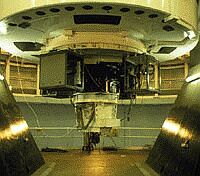Description:
TAURUS is a wide-field (9 arc min) imaging Fabry-Perot interferometer originally developed jointly by the RGO and Imperial College, London to map velocity fields of extended or multiple astronomical emission-line sources. The original instrument was in use at the INT, and TAURUS-2 is the new, fully automated version. It is one of the Cassegrain instruments and its main use is in measuring velocity fields of extended emission line objects - HII regions, planetary nebulae, supernova remnants and galaxies.
It is designed to accommodate a number of dedicated aperture masks and four etalons. Each etalon can be independently tuned to a defined frequency passband. Two TAURUS-2 units were produced, one for the AAT and one for the WHT. The WHT version was first used on 22 August 1987 for the first PATT-allocated observing session on the new telescope.
TAURUS-2 has a capability greater than that of earlier versions. In particular, the wavelength coverage has been extended to the range from 3650 Ã… to beyond 1 micron. In spite of the difference in focal ratio, the collimators for the WHT are compact three-element telephoto systems of similar design. The f/2 camera of focal length 120 mm consists of two cemented triplet components and two doublets. The design minimizes the number of air-glass surfaces. The wavelength range has been extended by making the inner components of the triplets of calcium fluoride crystal. There is no perceptible loss of efficiency in the presence of the external stop at the etalon.
The optimum choice of focal length for the camera depends on the angular size and surface brightness of the astronomical object. As an alternative option to the f/2 camera normally used, an f/4 camera was built so as to provide a larger image scale on smaller fields.
Although TAURUS-2 was originally constructed primarily for use as a Fabry-Perot interferometer, it can also be used as a focal reducer for imaging observations. The advantage of using TAURUS for imaging observations over using a CCD direct (e.g. at the auxiliary port of the A&G) is that it provides a plate scale better matched to the image size. When an EEV CCD with a pixel size of 22 microns is used direct at f/11, the scale is 0.1 arcsec/pixel, oversampling the image and providing only a limited field. TAURUS with the f/4 camera provides a scale of 0.27 arcsec/pixel, whilst TAURUS with the f/2.1 camera provides a scale of 0.51 arcsec/pixel.
Time allocations:
Nights scheduled since semester 2007B
Instrument information: http://www.ing.iac.es/astronomy/observing/manuals/html_manuals/wht_instr/taur
More:
TAURUS Users´ Manual
Research impact:
Scientific highlights (4)
Multimedia:
Photo archive (2)



